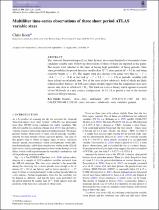| dc.contributor.author | Koen, C | |
| dc.date.accessioned | 2022-10-28T17:46:13Z | |
| dc.date.available | 2022-10-28T17:46:13Z | |
| dc.date.issued | 2019-09 | |
| dc.identifier.citation | Chris Koen, Multifilter time-series observations of three short period ATLAS variable stars, Monthly Notices of the Royal Astronomical Society, Volume 490, Issue 1, November 2019, Pages 1283–1293, https://doi.org/10.1093/mnras/stz2597 | en_US |
| dc.identifier.issn | 1365-2966 | |
| dc.identifier.uri | https://doi.org/10.1093/mnras/stz2597 | |
| dc.identifier.uri | http://hdl.handle.net/10566/8094 | |
| dc.description.abstract | The ‘Asteroid Terrestrial-impact Last Alert System’ discovered hundreds of thousands of new
candidate variable stars. Follow-up observations of three of these are reported in this paper.
The targets were selected on the basis of having high probability of being periodic (false
alarm probability for period detection smaller than 10−5), short periods (P < 0.2 d), and being
relatively bright (g
< 17). The targets were also chosen to be either very blue (g − i
<
−0.4, r − z
< −0.4) or very red (g − i
> 2.2, r − z
> 1.5) as periodic variables with
these colours are relatively rare. Two of the stars are hot subdwarfs, both of which are likely
reflection effect binaries. In both cases simple models suggest that the companions may have
masses very close to or below 0.1 M . The third star is also a binary, which appears to consist
of two M dwarfs in a near contact configuration. At 0.12 d its period is one of the shortest
known for M-type binaries. | en_US |
| dc.language.iso | en | en_US |
| dc.publisher | Oxford University Press | en_US |
| dc.subject | binaries: close – stars | en_US |
| dc.subject | low mass – subdwarfs – stars | en_US |
| dc.subject | Multifilter | en_US |
| dc.subject | ATLAS variable stars | en_US |
| dc.title | Multifilter time-series observations of three short period ATLAS variable stars | en_US |
| dc.type | Article | en_US |

